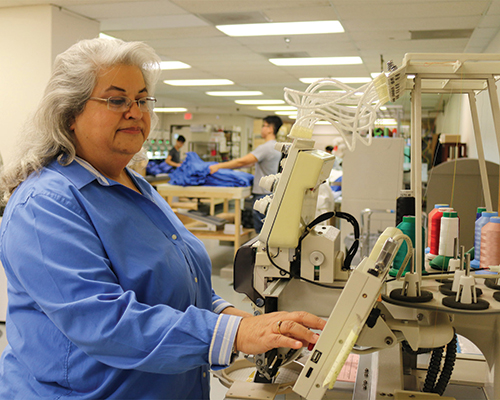Machine Embroidery Needles 101
Understanding the differences between machine embroidery needles and knowing which needle to use for each project will go a long way in developing your skills as a proficient commercial embroiderer.
FULL STORY
There recently has been a virtual explosion of personalization, including monograms, in many decorating disciplines. From heat-applied vinyl initials on rain boots to custom sterling silver monogrammed jewelry, social media has helped fuel the demand for customization.
Even the smallest embroiderer can take online orders for personalized baby blankets, wedding handkerchiefs and monogrammed tennis shoes by posting images of completed products on websites for home- and hand-crafted products, such as Etsy.com. Thousands of singlehead machines have been sold to entrepreneurial-minded Americans to satisfy this market.
Naturally, singlehead machines are ideal for fulfilling requests for these one-offs, but how suitable are they for other kinds of orders? And where do 4- and 6-head machines fit into the mix for embroidery-machine buyers?
The Trend
The ratio of singleheads sold compared to multiheads has increased for at least the past decade. But the trend has accelerated in the past two to three years, according to Larry Lawley, owner of Data-Stitch Inc., a Texas-based equipment company.
“Years ago, the cost for a singlehead was much higher than it is today,” Lawley says. “In comparison, the cost per embroidery head on a multihead machine was about half the price of a singlehead machine. The lower per-head cost was a powerful influencer in justifying a multihead purchase. Buyers learned that large multihead [machines] had more downtime for setup, thread breaks, bobbin and hoop changes. The flexibility and eventual lower-priced singlehead models helped them gain market share.”
Jason Starkey of Stitch It Intl., an SWF distributor, says the company sells more singlehead machines than multihead machines. Todd Somers, sales representative for Stitch It Intl., advises his customers that singleheads provide a good starting point for their businesses.
“They can always use a singlehead [machine] in their businesses,” Somers says. “Unless it’s an unusual situation, I tell new [embroidery business owners] to start with a singlehead. Twenty to 30% of my customers return to get a multihead machine later.” He adds that with the uptick in the economy, 6-head machine sales have improved.
Bob Stone, vice president of sales for Barudan America, says the company sells more multiheads than singleheads, and reinforces the popularity of the 6-head.
“First-time buyers are most comfortable with singlehead machines, but we sell about 60% multiheads to 40% singleheads, with the 6-head being our biggest-selling machine,” he says. “Some embroidery previously done outside the U.S. is coming back, and we’re seeing growth in multihead shops, particularly in cap operations.”
He adds that advances in networking software have made it possible for large shops to use singleheads more effectively. Multiple singleheads can work collectively on large orders or individually on small orders and personalized items.
“Personalization is driving more than just new people,” Stone says. “You can go to the New Era website and customize your own hat. You pay a price for it, but you can do it.”
This proves that even the largest companies see the personalization trend. Moreover, a singlehead machine can be useful in shops with a mix of equipment and can make sense for sampling, personalization or production.
Which Came First?
With the buying public increasingly using online selling sites like Etsy, it’s possible for anyone with a computer to shop 24/7 for custom embroidery. So which came first: small cottage embroiderers creating demand for personalized items through social media and internet pin boards, or affordable multi-needle cylinder-arm crossover models targeting the embroidery enthusiast market?
Whichever happened first, home sewing retailers have sold thousands of crossover models, helping to fulfill the growing appetite for monograms and other personalized goods. Appliquéd children’s clothing, customized plush animals and many more products with high perceived value are offered on numerous sites and networks, including Facebook, Groupon and Living Social. Suddenly, customized gifts and other embroidery purchases are much more visible and accessible to the average consumer.
This is a good development for all embroidery businesses, even those with no online presence. Cottage embroiderers are a welcome addition to the professional embroidery community for their influx of fresh products and ideas.
Embroidery trends are cyclical, so expect the popularity of monograms to somewhat recede, then return in the natural ebb and flow of popular products. With the number of singlehead models in use, you can bet embroiderers will be ready.
Deborah Jones has more than 30 years of experience in the computerized embroidery field. She runs myembroiderymentor.com and regularly speaks at the Imprinted Sportswear Shows (ISS). For more information or to comment on this article, email Deborah at djones@myembroiderymentor.com.
The Cost Factor
Economy of scale is a factor for buyers to consider when deciding on equipment size. In some product lines, it’s actually less expensive to buy two singleheads than to buy a 2-head machine.
Other benefits include portability and additional shop-layout options. Two singleheads also allow more job-flow flexibility unless the 2-head machine’s heads operate independently of each other.
Similarly, in certain brands there may be just a few thousand dollars separating the price of a 4-head model and a 6-head model. When space allows, a 6-head machine provides a lot more productivity with just a marginal price increase.
Understanding the differences between machine embroidery needles and knowing which needle to use for each project will go a long way in developing your skills as a proficient commercial embroiderer.
FULL STORYWhether you’re running a small boutique embroidery shop or managing a large-scale decorated-apparel operation, attracting more customers to your business is crucial for growth and sustainability.
FULL STORYThere’s nothing more frustrating than being under pressure to get a job out and having something go wrong—and there are so many things that can go wrong!
FULL STORY